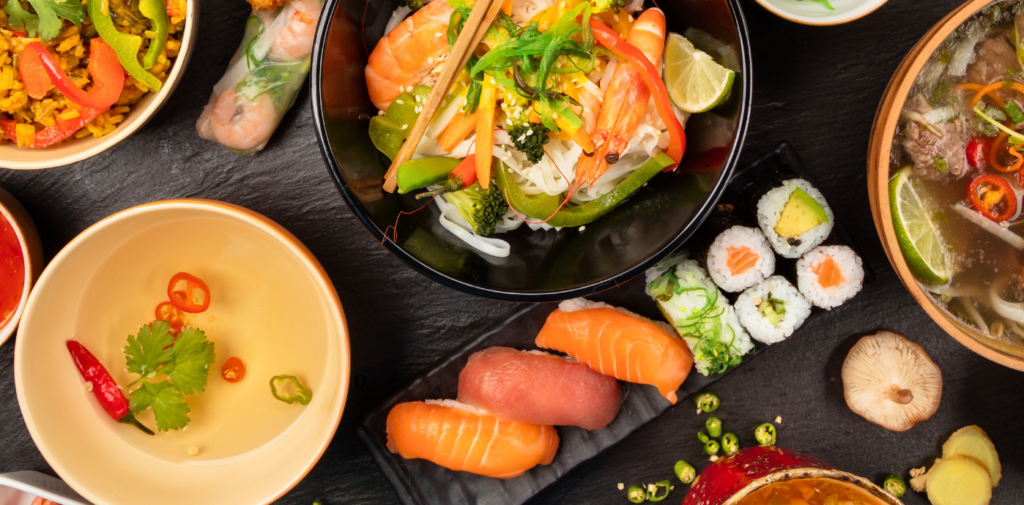Asian Food Tips: Enhancing Your Culinary Experience
Asian cuisine offers an incredible diversity of flavors, ingredients, and cooking techniques that are both exciting and healthy. Whether you’re looking to reduce calories in Asian cooking, learn new methods, or discover budget-friendly meal ideas, there are plenty of tips to elevate your cooking. In this guide, we’ll cover essential Asian food tips, focusing on healthier choices, ingredient knowledge, and practical techniques for making delicious meals right at home.

1. Healthier Cooking Techniques for Asian Cuisine
Asian cooking is often lauded for its healthy approach to food, but with a few simple tweaks, you can make it even better for your health. Stir-frying, steaming, and grilling are some of the healthiest methods used in many Asian dishes, as they preserve the natural flavors of ingredients while reducing the need for added fats and oils.
Key Healthier Techniques:
-
Stir-frying: Using minimal oil while cooking over high heat ensures a flavorful and crispy texture without excess calories.
-
Steaming: This technique preserves nutrients in vegetables and proteins, offering a light yet flavorful option.
-
Grilling: Grilling meats and vegetables enhances their taste without adding heavy sauces or fats.
By incorporating these methods into your cooking, you can enjoy healthier versions of your favorite Asian dishes without compromising on taste.
2. Reducing Calories in Asian Cooking
If you’re looking to reduce calories in your Asian meals, there are simple tricks that can make a big difference. Asian dishes often feature rice, noodles, and fried elements, which can be calorie-dense. Fortunately, by substituting ingredients and adjusting preparation methods, you can significantly lower the calorie content while maintaining flavor.
Tips to Cut Calories:
-
Swap white rice with brown rice: Brown rice is a whole grain, offering more fiber and fewer calories compared to its refined counterpart.
-
Use cauliflower rice: A low-carb and calorie alternative that mimics the texture of rice in stir-fries and curries.
-
Grill or steam instead of deep-frying: Opt for grilling or steaming your proteins and vegetables instead of deep-frying, which can add unnecessary calories.
With these simple changes, you can enjoy the bold flavors of Asian food while keeping your meals lighter and healthier.

3. Mastering Asian Ingredients
A wide variety of ingredients are essential to Asian cooking. Whether you’re making a spicy Thai curry or a Japanese sushi roll, understanding the key ingredients is crucial for authentic flavors. The right combination of spices, sauces, and fresh produce can elevate any dish.
Common Asian Ingredients:
-
Soy sauce: Used in many Asian dishes, soy sauce adds depth and saltiness to stir-fries, marinades, and soups.
-
Rice vinegar: Adds a tart, slightly sweet flavor, perfect for dressings and sushi rice.
-
Ginger: A key ingredient in Chinese, Thai, and Japanese cuisine, ginger adds a fresh, zesty flavor to dishes.
-
Fish sauce: A salty, umami-packed sauce that enhances the flavor of soups, stews, and curries.
Understanding how to balance these ingredients will help you create authentic and delicious dishes every time.
4. Budget-Friendly Asian Meals
Eating Asian food at home can be incredibly cost-effective, especially if you know how to use your ingredients wisely. By learning to make the most out of basic pantry items and exploring budget-friendly cooking tips, you can create satisfying and delicious meals without breaking the bank.
Budget-Friendly Tips:
-
Bulk-buy staple ingredients: Items like rice, noodles, and soy sauce are affordable and last a long time when purchased in bulk.
-
Use seasonal vegetables: Fresh, in-season vegetables are not only cheaper but also more flavorful.
-
Repurpose leftovers: Turn yesterday’s stir-fry into today’s soup or salad to reduce waste and save money.
By making a few strategic choices, you can prepare nutritious, filling meals that don’t cost a fortune.

5. Incorporating More Vegetables into Asian Dishes
One of the standout features of Asian cuisine is the heavy reliance on vegetables. Whether you’re cooking a Chinese stir-fry or a Korean bibimbap, vegetables are a key part of the meal. Incorporating more vegetables into your dishes not only adds vibrant colors but also boosts their nutritional content.
Easy Ways to Add Vegetables:
-
Stir-fry vegetables: Use a variety of colorful vegetables like bell peppers, carrots, and broccoli in your stir-fries.
-
Add leafy greens: Bok choy, spinach, and kale are great additions to soups, curries, and rice dishes.
-
Use mushrooms: Mushrooms add umami and texture to dishes like ramen or hot pots.
With a little creativity, you can increase your vegetable intake and enjoy the health benefits they offer.
6. Balancing Flavors in Asian Cooking
Balancing the five key flavors of sweet, sour, salty, bitter, and umami is essential in Asian cooking. Mastering this balance will help you create dishes that are flavorful and satisfying.
Tips for Flavor Balance:
-
Sweetness: Sweeteners like sugar or honey are often used in stir-fries and sauces.
-
Sourness: Vinegar, lime juice, and tamarind add tartness to balance out rich or fatty flavors.
-
Saltiness: Soy sauce, fish sauce, and salt are used to provide depth and seasoning.
-
Umami: Ingredients like miso, mushrooms, and seafood are rich in umami, adding savory depth to your dishes.
A well-balanced dish will have harmony in its flavor profile, ensuring that no single taste overpowers the others.
7. Using Fresh Herbs in Asian Cuisine
Fresh herbs are essential for enhancing the flavors of many Asian dishes. Whether you’re making Vietnamese pho or Thai curry, herbs like cilantro, mint, and basil can elevate the dish’s aroma and freshness.
Common Fresh Herbs in Asian Dishes:
-
Cilantro: Adds a fresh, citrusy flavor, commonly used in Vietnamese and Thai dishes.
-
Mint: Perfect for Thai salads and Indian yogurt-based dishes like raita.
-
Basil: A must-have for Thai and Vietnamese dishes, with varieties like Thai basil providing a unique licorice flavor.
Using fresh herbs will not only add fragrance and flavor but also make your meals feel lighter and more vibrant.
8. Perfecting Your Asian Sauces
Asian sauces are what tie many dishes together. From soy sauce and fish sauce to hoisin and teriyaki, each sauce has a unique flavor profile that can transform your dish. Learning how to make or choose the right sauce for each meal is crucial to mastering Asian cuisine.
Common Asian Sauces:
-
Soy sauce: Adds a salty, savory flavor to stir-fries, soups, and marinades.
-
Fish sauce: Offers a deep umami flavor, often used in Thai and Vietnamese cooking.
-
Teriyaki sauce: A sweet and savory sauce perfect for glazing meats or stir-fries.
-
Chili paste: Adds spice and heat, perfect for dishes like curries or noodles.
Understanding how to use these sauces effectively will help you bring out the best in your Asian cooking.

Conclusion: Bringing the Best of Asia to Your Kitchen
Incorporating these Asian food tips into your cooking can help you create healthier, more flavorful, and cost-effective meals. By understanding the right ingredients, techniques, and flavor profiles, you can master the art of Asian cuisine and bring a world of deliciousness into your home kitchen.
FAQs About Asian Food Tips
What are the healthiest cooking methods for Asian food?
-
Steaming, stir-frying, and grilling are some of the healthiest methods, as they preserve nutrients and reduce the need for excess oils and fats.
Can I use Asian ingredients in non-Asian dishes?
-
Absolutely! Many Asian ingredients like soy sauce, sesame oil, and miso can be used to enhance the flavor of non-Asian dishes such as soups, salads, and marinades.
How can I make my Asian meals more flavorful?
-
Focus on balancing sweet, sour, salty, bitter, and umami flavors, and don’t forget to use fresh herbs and the right sauces to bring depth and complexity to your meals.
Explore more tips and tools for automating your food-related projects at DUYTHIN.DIGITAL.




